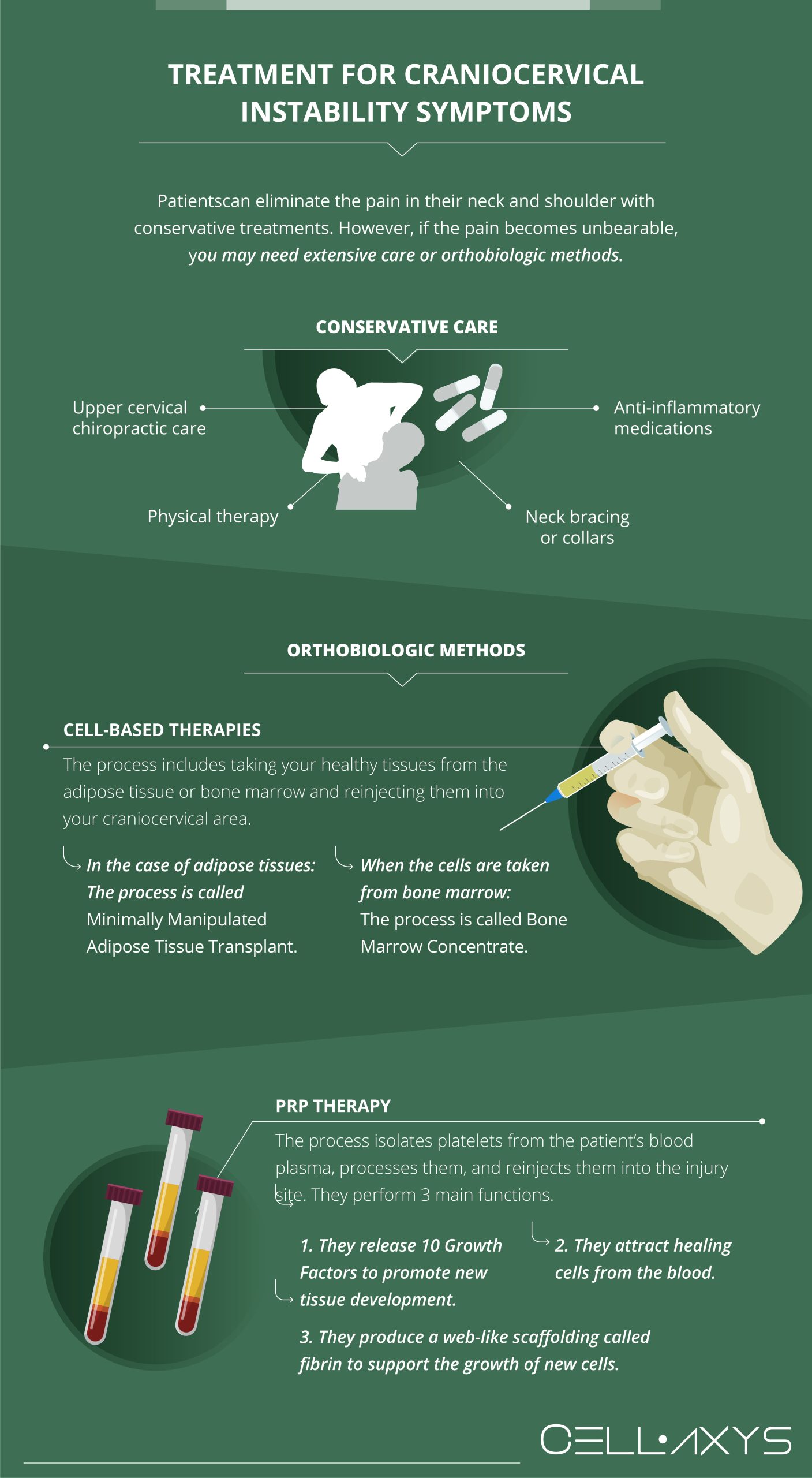Published on: November 24, 2022 | Updated on: August 29, 2024
Cervical instability or craniocervical instability (CCI) is a medical condition in which the ligaments holding your head to the upper neck become loose or relaxed. This results in excruciating pain close to your neck, skull, and shoulders.
CCI occurs due to the excessive movement of the patient’s vertebrae at the atlantoaxial joint (upper part of the neck) and the atlanto occipital joint (articulation between the atlas bone and the occipital bone). These joints are between the first two vertebrae (C1 and C2) and the skull. This instability can cause compression in the brain stem, vagus nerve, or spinal cord, along with several other symptoms.
CCI can even lead to rheumatoid arthritis if not treated on time. Luckily, many treatment options, including orthobiologic methods, are giving excellent results in relieving CCI symptoms.
7 Craniocervical Instability Symptoms To Look for
Are you feeling pulsating pain from the back of your head to your shoulders? If so, it could be a sign of craniocervical instability. Here are some other common symptoms that can help you identify craniocervical instability:
Heavy Head
One of the most common symptoms of craniocervical instability is having a heavy head with constant cervicogenic pain. It feels like your head might fall off your body or your neck can no longer support your head.
The condition occurs when the loosened ligaments fail to tighten the skull at one position. The head weight increases due to forward movement from the neutral alignment of the spine. As a result, many patients experience severe dizziness and posture problems.
Some patients have also reported a continuous urge to turn their heads down because of the uneasiness. This situation is somewhat similar to having a “bobblehead.”
Migraines
A migraine is a severe headache resulting in excruciating pain in a particular part of your head. It can be a specific vein or a brain chamber that’s been affected due to craniocervical instability.
Migraines usually observed due to cranial instability start from the base of your skull and radiate upward following the ram’s horn pattern. You may suddenly experience a shocking wave of migraines out of the blue or develop a constant chronic headache that lasts for hours or days.
Blurred Vision
Several patients complain about experiencing various visual problems with cervical instability. Visual impairment, like blurred vision, results from your throbbing forehead.
Cervical muscle instability can disturb your cognitive abilities and cause visual disturbances. Such disturbances may range from mild to severely affected eyes.
Brain Fog
Brain fog is a significant symptom of craniocervical instability. It refers to the unintentional scattered thoughts, usual forgetfulness, inability to concentrate, haziness, and lack of mental sensing are all signs of brain fog.
People suffering from CCI struggle to remember everyday things. They’re always full of different thoughts. Extreme brain fogging may lead to cognitive impairment.
Elevated Heart Rate
An elevated heart rate may indicate various bodily abnormalities, including craniocervical instability. In CCI, the vagus nerve that manages heartbeats gets stimulated by uncontrolled head movements.
The condition increases your heartbeats per minute, leading to postural orthostatic tachycardia syndrome (POTS). It is an autonomic movement disorder.
Neck and Shoulder Pain
The localized neck and shoulder pain is another common cranial instability symptom. First, the pain radiates outward from the base of your skull. Then, it starts to spread throughout the neck to the shoulders. The pain increases further with continuous muscle movement.
For example, whenever you flex your arm muscles or move your shoulders laterally, you’ll feel a sharp, stinging pain run down your spine. The throbbing pain in the trapezius and scapular region of the neck pain is known as Cervicalgia.
Chronic Muscle Fatigue
Craniocervical instability usually occurs due to constant strain on your muscle fibers. First, the ultimate nonstop pressure exhausts your muscles, resulting in swollen mass. Then, the inflated muscle mass starts throbbing with pain due to inflammation, giving you chronic fatigue for days, maybe weeks.
Usual fatigue may fade away with time, but if your condition is severe, you may experience complete immobility. Even getting up from your bed will feel like climbing mountains.
Other Symptoms of Cervical Instability
You might experience a few other symptoms depending upon your condition, such as:
- Occipital headaches
- Muscle spasms
- Jaw pain
- Difficulty in swallowing
- Light sensitivity
- Ringing in ears (Tinnitus)
- Orthostatic intolerance
- GI disturbances (diarrhea, constipation, flatulence, etc.)
Treatment for Craniocervical Instability Symptoms

Patients with mild craniocervical instability symptoms can eliminate the excruciating pain in their neck and shoulder with conservative treatments. However, if the pain becomes unbearable, you may need extensive care or orthobiologic methods.
Conservative Care
Some effective conservative methods include:
- Upper cervical chiropractic care
- Physical therapy
- Neck bracing or collars
- Anti-inflammatory medications
Orthobiologic Methods
With advancements in regenerative medicine, orthobiologic methods are giving exceptional results in treating multiple neck, shoulder, and spine-related conditions. Over the years, cell-based therapies (also known as stem cell therapies) and platelet-rich plasma therapy (PRP) have become increasingly popular among patients as they are less invasive and less painful with a very short recovery period.
At CELLAXYS, we perform orthobiologic treatments with an excellent recovery and healing rate. We harvest healthy cells from different body parts, process them, and reinject them into your injury site. Depending on your condition, we opt for any of the two types of methods:
- Cell-Based Therapies: The process includes taking your healthy autologous or own tissues from the adipose (fat) tissue or bone marrow and reinjecting them into your craniocervical area. In the case of fatty tissues, the process is called Minimally Manipulated Adipose Tissue Transplant (MMAT). When the cells are taken from bone marrow, the process is called Bone Marrow Concentrate (BMAC).
- PRP Therapy: The process isolates platelets from the patient’s blood plasma, processes them, and reinjects them into the injury site. Platelets are the first line of defense in our body. They perform three main functions. First, they release 10 Growth Factors to promote new tissue development. Then, they attract healing cells from the blood. Finally, they produce a web-like scaffolding called fibrin to support the growth of new cells. Many platelets in the injury site promote quick healing and healthy recovery.
Cell-based therapies and PRP are outpatient procedures, meaning you can go home right after the procedure. MMAT and BMAC take 1.5 to 2 hours, while PRP takes 45 minutes.
Sources
Footnotes
- Fiester P, Rao D, Soule E, Orallo P, Rahmathulla G. Anatomic, functional, and radiographic review of the ligaments of the craniocervical junction. Journal of Craniovertebral Junction & Spine. 2021;12(1):4.
- Chu EC, Wong AY, Lee LY. Craniocervical instability associated with rheumatoid arthritis: a case report and brief review. AME Case Reports. 2021;5.
- Antonaci F, Bono G, Chimento P. Diagnosing cervicogenic headache. The Journal of Headache and Pain. 2006;7:145-8.
- Chu EC, Al Zoubi F, Yang J. Cervicogenic dizziness associated with craniocervical instability: a case report. Journal of Medical Cases. 2021;12(11):451.
- Thompson‐Harvey A, Hain TC. Symptoms in cervical vertigo. Laryngoscope investigative otolaryngology. 2019;4(1):109-15.
- Ischebeck BK, de Vries J, Van der Geest JN, Janssen M, Van Wingerden JP, Kleinrensink GJ, Frens MA. Eye movements in patients with Whiplash Associated Disorders: a systematic review. BMC Musculoskeletal Disorders. 2016’;7:1-1.
- Bragée B, Michos A, Drum B, Fahlgren M, Szulkin R, Bertilson BC. Signs of intracranial hypertension, hypermobility, and craniocervical obstructions in patients with myalgic encephalomyelitis/chronic fatigue syndrome. Frontiers in neurology. 2020:828.
- Blitshteyn S. Is postural orthostatic tachycardia syndrome (POTS) a central nervous system disorder?. Journal of Neurology. 2022;269(2):725-32.
- Zeigelboim BS, Fonseca VR, Mesti JC, Gorski LP, Faryniuk JH, Marques JM. Neurotological findings at a health unit for adults with cervicalgia. International Archives of Otorhinolaryngology. 2016;20:109-13.
References
- Cervical Spine Anatomy. Medscape. Accessed 2/26/2024.
- Symptoms and conditions of Craniocervical and Cervical Instability. Caring Medical. Accessed 2/26/2024.
- Cervical Instability. Physiopedia. Accessed 2/26/2024.
CELLAXYS does not offer Stem Cell Therapy as a cure for any medical condition. No statements or treatments presented by Cellaxys have been evaluated or approved by the Food and Drug Administration (FDA). This site contains no medical advice. All statements and opinions are provided for educational and informational purposes only.
Dr Pouya Mohajer
Author
Pouya Mohajer, M.D. is the Director of Spine and Interventional Medicine for CELLAXYS: Age, Regenerative, and Interventional Medicine Centers. He has over 20 years of experience in pain management, perioperative medicine, and anesthesiology. Dr. Mohajer founded and is the Medical Director of Southern Nevada Pain Specialists and PRIMMED Clinics. He has dedicated his career to surgical innovation and scientific advancement. More about the doctor on this page.
Dr Pejman Bady
Contributor
Dr. Pejman Bady began his career over 20 years ago in Family/Emergency Medicine, working in fast-paced emergency departments in Nevada and Kansas. He has served the people of Las Vegas as a physician for over two decades. Throughout this time, he has been met with much acclaim and is now the head of Emergency Medical Services in Nye County, Nevada. More about the doctor on this page.









